West Bromwich, Staffordshire
Up to 1834
In 1735, a former nail warehouse on what is now St Clement's Lane in West Bromwich was purchased for £87 10s for use as a workhouse. Various extensions were made to the building, which by the 1770s could accommodate 100 paupers. In 1791, to stop the inmates getting out, it was decided to build boundary wall with spikes along the top. By 1814, the building was found to be completely unfit. However, plans for a replacement building were never carried out due to lack of funds.
In 1766, some almshouses on Meeting Street in Wednesbury were converted for use as a workhouse and could house up to 60 inmates. By 1768, a small cell had been added to confine any miscreant in the parish, but appears to have been rarely used. The workhouse governor's favoured method of punishment was to chain wrongdoers to the fire grates. An 1786 inventory of the workhouse included the following: governor's kitchen, cellar, a bedroom over the pantry with 2 beds, a lower house and men's ward, a lower parlour, a men's lodging room with twelve beds, a women's kitchen, a women's lodging room with 20 beds, a brewhouse and a bedroom above, with 2 spare beds. Little regular work was found for the inmates, although occasionally they were hired out to local employers. In 1828, the governor was William Halfpenny, with the location then referred to as Workhouse lane..
At Handsworth, a workhouse was in operation by 1811 on land purchased by the Overseers in 1794. It was situated near to the old town hall, on a plot bounded by College Road, Slack Lane and Oxhill Road.
After 1834
West Bromwich Poor Law Union formally came into being on 2nd December 1837. Its operation was overseen by an elected Board of Guardians, 26 in number, representing its 6 constituent parishes as listed below (figures in brackets indicate numbers of Guardians if more than one):
County of Stafford:
West Bromwich (10), Handsworth and Perry Barr (4), Wednesbury (6).
County of Salop:
Oldbury (4), Warley Salop.
County of Worcester:
Warley Wigorn.
The population falling within the Union at the 1831 census had been 34,616 with parishes ranging in size from Warley Wigorn (population 921) to West Bromwich itself (15,327). The average annual poor-rate expenditure for the period 1834-6 had been £6,584 or 3s.10d. per head of the population.
Initially, the union retained the old premises in Wednesbury and West Bromwich. In 1839, the Poor Law Commissioners reported that West Bromwich one of around 35 Unions which "for the present decline to concur in providing an adequate Workhouse". However, a new workhouse was eventually erected in 1857-8 on Hallam Street at the east of West Bromwich. The old parish premises were then closed, with the Wednesbury building survving until 1920.
The new workhouse was designed by the partnership of Briggs and Everall and could accommodate 820 inmates. Its location and layout are shown on the 1901 map below.
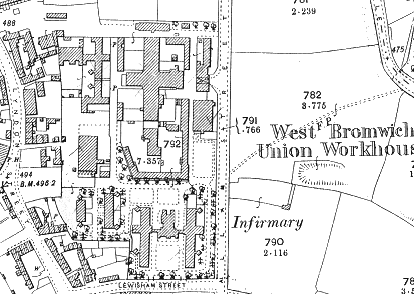
West Bromwich site, 1901
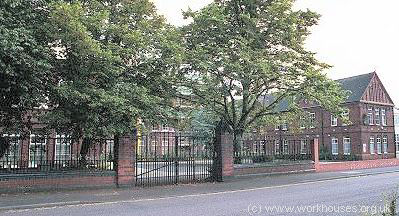
West Bromwich infirmary from south-west, 2000.
© Peter Higginbotham.
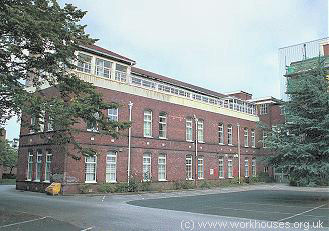
West Bromwich infirmary from south-east, 2000.
© Peter Higginbotham.
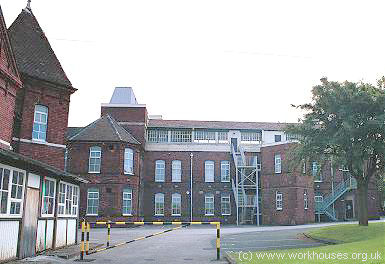
West Bromwich infirmary from west, 2000.
© Peter Higginbotham.
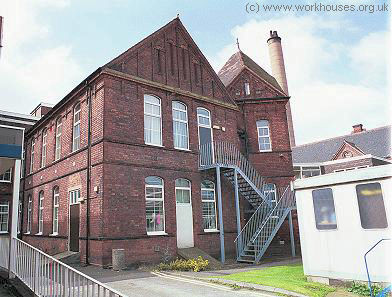
West Bromwich itch and venereal wards, 2000.
© Peter Higginbotham.
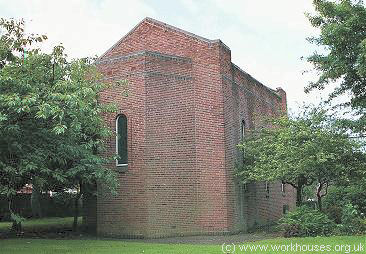
West Bromwich chapel, 2000.
© Peter Higginbotham.
In 1887, a new block containing a board-room and relief offices was erected fronting onto Hallam Street. The building was deigned by Messrs. Henman and Timmins.
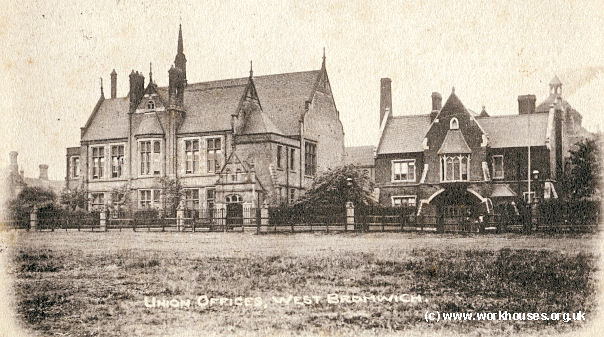
West Bromwich board-room (left) and entrance from north-east, c.1904.
© Peter Higginbotham.
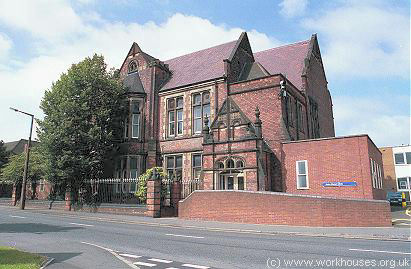
West Bromwich board-room from north-east, 2000.
© Peter Higginbotham.
The main workhouse buildings have been demolished but the infirmary and several surviving peripheral buildings became part of Sandwell Hospital, later Hallam Day Hospital.
In 1842, the Commissioners investigating the employment and conditions of children in mines and manufactories, discovered that workhouse boys, some as young as eight, were being sent on "apprenticeships" of up to twelve years working in coal mines. As a result, some unions in the coal-mining districts of South Staffordshire and adjacent areas were asked to provide detailed information on the children who had been apprenticed in the mining industry in recent years. West Bromwich recorded five such instances, detailed below, all dealt with by parish officers rather than the Board of Guardians. In every case, the boy concerned had been apprenticed, without any premium being paid, until he was 21 years old.
| Date Bound | Name | Age | To whom bound | Name of mine |
|---|---|---|---|---|
| 28 April 1840 | John Ramsbottom | 10 | Thomas Teece | Coal mine |
| 28 April 1840 | William Gabrell | 9 | Enoch Taylor | ditto |
| 15 August 1840 | Edward Roberts | 13 | Joseph Simpkin | ditto |
| 25 August 1840 | William Stevens | 10 | Thos. Lawrence | Stone mine |
| 5 June 1841 | Samuel Lissimore | 12 | John Thomas | Coal mine |
In 1869, West Bromwich formed a partnership with the neighbouring Walsall Union to set up the Walsall and West Bromwich School District. The School District operated a district school at Wigmore.
In 1911, West Bromwich again joined with Walsall to form the Walsall and West Bromwich Joint Committee for providing specialised care for certain categories of paupers away from the main workhouse. The Committee purchased Great Barr Hall at the north-west of West Bromwich and in 1918 opened a "colony for mental defectives".
Staff
Inmates
Records
Note: many repositories impose a closure period of up to 100 years for records identifying individuals. Before travelling a long distance, always check that the records you want to consult will be available.
- Sandwell Community History and Archives Service, Smethwick Library, High Street, Smethwick B66 1AA. Has Guardians' minutes (1891-1912).
Bibliography
- Robinson, Keith (2020) Voices from the Wednesbury Workhouse and the Parish Poor 1750–1900
Links
Unless otherwise indicated, this page () is copyright Peter Higginbotham. Contents may not be reproduced without permission.


